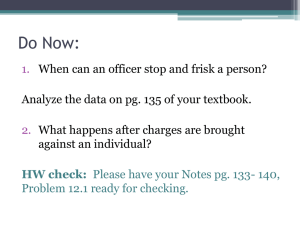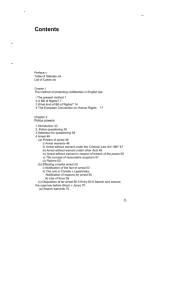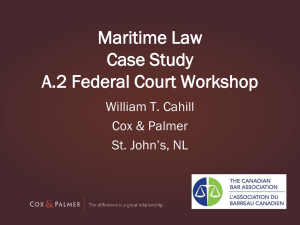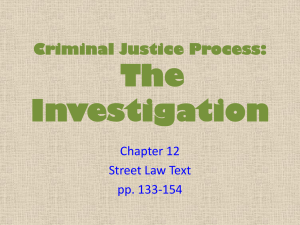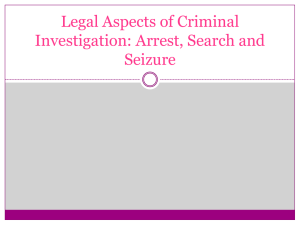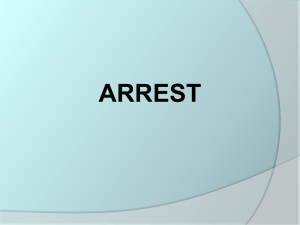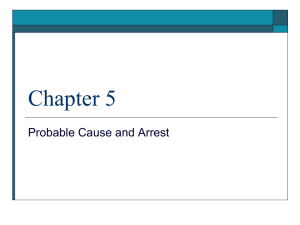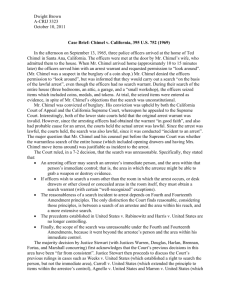CH 12 Powerpoint - Sierra College Administration of Justice
advertisement
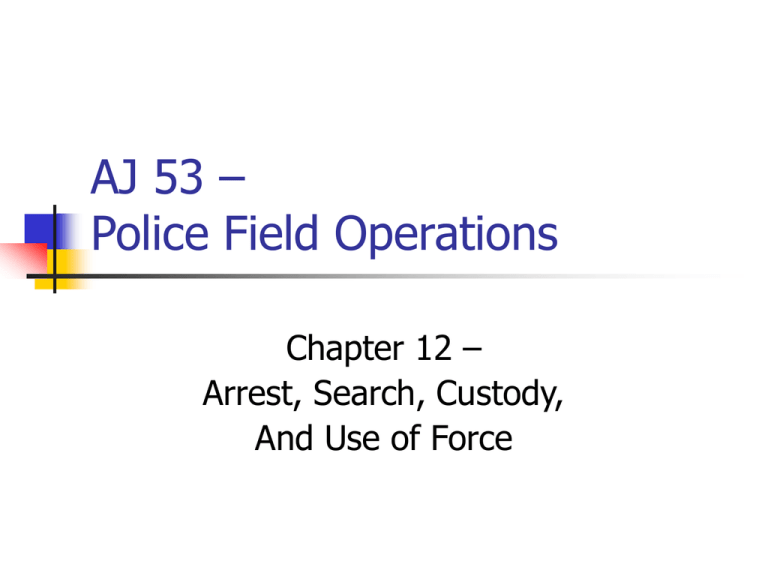
AJ 53 – Police Field Operations Chapter 12 – Arrest, Search, Custody, And Use of Force Police Powers of Arrest Why is a Peace Officer’s authority to arrest such a powerful responsibility? It means taking away a person’s liberty! Officers must understand/appreciate this responsibility What determines an arrest? Constitutional Protections Criminal Laws Laws of Arrest Department Policy Officer Discretion Criminal Behavior Crime requires union of… Criminal Act (or Omission), and Intent (or Negligence) Types of Arrests… Warrant Arrest order signed by Magistrate Specific person, charges, etc. Without Warrant Other circumstances allowing lawful arrest Warrantless Arrests by Peace Officers (836 PC) Reasonable Cause that a crime (misdemeanor or felony) was committed in officer’s presence Felony committed, not in officer’s presence Perceived by any of the senses Elements of crimes, corpus delicti, etc. Reasonable Cause to believe that a felony was committed, whether or not the felony actually occurred Based on reasonable observation/interpretation Arrest Considerations Knock and Notice Notification of Arrest to Arrestee Authority, charges, etc. (841 PC) Diplomatic Immunity Requirement to announce and identify unless exigent circumstances dictate otherwise Ambassadors and families immune from arrest Right to contact consular official Entrapment Idea of criminal activity implanted by police Levels of Police Interaction Consensual Contact Detention Person free to leave, does not have to cooperate or answer questions No force/coercion/restraint may be used Person not free to leave based on Reasonable Suspicion Pat-down for weapons may be justified Arrest Actual restraint of the person or submission to custody Using Force to Arrest Persuasion whenever possible, Force if necessary! How much force may an officer use? Only what is reasonable and necessary Once compliance/control achieved, force no longer needed or justified Officers must exercise control of… Self – Suspect – Situation Related Penal Code Sections 834a PC 835 PC Citizen’s duty to refrain from resisting arrest Officer may use reasonable restraint to arrest 835a PC Officer may use reasonable force to Effect arrest Prevent escape Overcome resistance “Reasonable” should be defined from the perspective of the individual officer at that particular moment in time! Officer Use of Lethal Force 196 PC – Justifiable Homicide by PO In obedience to court judgment To overcome actual resistance Death-penalty executions Only if deadly force being used To retake into custody an escaped/fleeing felon Only if escape creates imminent deadly threat Use-of-Force Considerations Equal in Proportion Force used must be in equal proportion to force being used against you Appropriate choice of available use-of-force options Fear Not the same as cowardice! What were you “afraid of” that caused you to use force? Important to include in reports/documentation Use-of-Force (continued) Imminence Threat requires an immediate response If threat increases, decreases, or disappears, use-of-force response changes accordingly Reasonable-Person Test From viewpoint of officer using force From viewpoint of person witnessing event Use-of-Force Continuum Guided by Laws & Department Policy Various models Ladder, elevator, spokes of a wheel Common elements… Command Presence, Verbal Commands Hands-On, Control Holds, Takedowns Intermediate Force Lethal Force Use-of-Force Options Command Presence Weaponless Defense Arrest & Control, FBI, Koga, Cameron Martial Arts training? Less-Lethal Academy & On-the-Job-Training OC, Baton, Taser, Bean Bag, Pepperball Lethal Force Handgun, Shotgun, Patrol Rifle, etc. Use of Firearms Potentially taking a human life is an awesome responsibility! Safety is absolutely important at all times Common Elements of “Shooting Policies” Minimum Training & Qualification Standards Drawing, Firing, etc. Warning Shots, Vehicles, Animals, etc. Reporting & Documentation Requirements Follow-up Investigation Procedures Types of Searches Frisk or Pat-Down Field/Arrest Search Cursory search of outer clothing for weapons only, during lawful Detention Thorough search for weapons, contraband, means of escape Strip Search/Body-Cavity Search At the jail during Booking Searching Techniques Maintain position of advantage Maintain control over subject at all times Top-down, waistband first, quadrants Three possible positions Verbal and physical Handcuffs if necessary Systematic and Thorough! Keep subject off-balance Standing Kneeling Prone Issues when searching Females? Juveniles? Handcuffing Techniques When and how? Become proficient in variety of handcuffing techniques from various positions Governed by Training & Department Policy Behind the back! Standing, kneeling, prone Maintain control over subject Speed-Cuffing Apply handcuffs as quickly & smoothly as possible Double-lock as soon as practicable Transporting Prisoners Thoroughly search vehicle at beginning of every patrol shift Search back seat area after every prisoner transportation Use seatbelts, restraints per Policy You are ultimately responsible for prisoner’s health, safety, and well-being! Vehicle Searches Consent Plain View Based on observations, investigation, etc. Incidental to Arrest Items found in plain view can be seized Probable Cause Given freely without coercion Limited access without a warrant Inventory Searches Towed & stored, recovered stolen etc. Searches of Premises Obtain Warrant whenever possible! Warrant Exceptions… Consent Plain View Fresh Pursuit Exigent Circumstances Destruction of Evidence Chimel vs. CA May search arrestee and immediate area for… Instrumentalities/fruits/evidence of the crime Contraband Weapons that may be used for assault/escape



